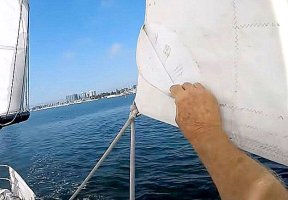For years now, I've been considering making a set of sails: a 90% jib and a main. I've recently upgraded to a new, larger industrial walking foot zig zag sewing machine for other projects, and I have the space and (finally!) time to take on these projects. I just entered talks with Sailrite to create the specifications, which will result in a package of materials and pre-cut panels, with stitching and assembly performed in my garage. I'm currently learning toward longevity (Dacron) for both sails with the gains in performance and strength of a tri-radial cut over cross cut. But this is a new area for me, so open to suggestions. These will be used mostly for local and coastal cruising, and will be backups on longer passages.
Just casting a broad inquiry here: Who has made sails, and what wisdom is there to be acquired for this DIY project?
Ignacio
p.s. I just finished a rather extensive refit of my boat. Here she is. The sails are the next project on that undying list.
Just casting a broad inquiry here: Who has made sails, and what wisdom is there to be acquired for this DIY project?
Ignacio
p.s. I just finished a rather extensive refit of my boat. Here she is. The sails are the next project on that undying list.
Attachments
Last edited:


